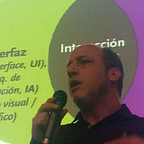Design Thinking is as useful as astrology, but gets better press
Every methodology promises us the success that eludes all others. And when they fail us, they tell us that the problem is… that we need more methodology. There is another category that works the same way: that of astrologers and charlatans.
If biology teaches us anything, it is that everything happens at the same time.
Books show us biological processes as ordered sequences so that we can get an idea, but reality is something else.
We don’t have pipelines as if we were refineries. The biological field doesn’t work that way. Understanding metabolic pathway schemes takes time, concentration and effort. At the end of which, if we thought we understood the metabolic pathway, we would be fooling ourselves: we are just understanding the scheme.
The same goes for the design process.
“Textbook” processes are narrative simplifications.
To paraphrase Jared Spool, “textbook” processes are the author’s fiction of what he would like his next project to look like.
In my research, a process is a post-hoc rationalization of the idealized portions of work. When people describe their process, they are describing how they’d like to describe how a future project went down — Jared Spool
No design project ever followed an orderly process. Design Thinking, Double Diamond, etc, are didactic simplifications for clients or beginners.
Taking them as guarantees or prescriptions is a mistake that the model, with its false promises, encourages us to make.
For every complex problem, there’s a solution that is simple, neat, and wrong
Beware of buying simplifications as if they were truths.
For example, look at all the things Christina Wodtke found that Design Thinking leaves out (and that clients and beginners ignore):
All models are wrong; some are useful.
The definition of processes is the most complex problem in Design. Because when you finish understanding and standardizing them… they become predictable, mechanizable, and the design process begins to emerge somewhere else.
Connecting with a community of practice and relying on experts, mentors and critics are essential to achieve a balanced view and mature as professionals.
The anti-agility behind commoditization
Behind the methodologies sold as magical solutions lies the narrative that design problems can be approached mechanically, that processes ensure results, and that they are more important than people.
It is a narrative as strong as the law of gravity. Every methodology tends to gravitate around it, no matter how much it pretends otherwise.
Take the Agile Manifesto itself, declaring since the beginning of the century “Individuals and interactions over processes and tools”. But instead of developing individuals and interactions, companies prefer to hire “agile consultants” who offer false guarantees and magic recipes.
It is our role as professionals involved in the process to resist and fight this trend.
The alternative is to be the executors of the “rituals” proposed by the “gurus”. I find it very striking that one of them is called “Marty Cagan” (which in spanish means “f*ck you over”) and no one is a bit suspicious at all. Anyway.
